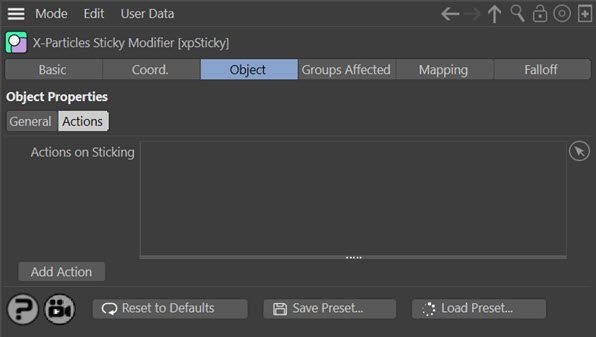Sticky Modifier
 The Sticky modifier will stick particles to an object and move them with the object if it moves, rotates, etc. This is an example of the modifier in action, sticking particles to two primitive objects. An action changes the particle colour when they stick:
The Sticky modifier will stick particles to an object and move them with the object if it moves, rotates, etc. This is an example of the modifier in action, sticking particles to two primitive objects. An action changes the particle colour when they stick:
Interface
This modifier has the following sections:
For the 'Groups Affected', 'Mapping', and 'Falloff' tabs, and for the buttons at the bottom of the interface, please see the 'Common interface elements' page.
Parameters
General quicktab

Enabled
Uncheck this switch to disable the modifier.
Mode
Independent [default setting]
In this mode, particles will be affected if they come into the field of effect of the modifier. X-Particle Actions will have no effect on the modifier in this mode.
Action-Controlled
In this mode, the modifier will only act on a particle when told to do so by an Action. Until that point, the particle will not be affected, but once activated for a particular particle, the modifier will continue to influence it as long as it is in the field of effect of the modifier. The modifier's effect on a particle can be halted by means of another Action, if desired.
Probability
This is the probability that a particle will stick to an object if it comes within range. If it is set to 100% the particle will always stick; if it is 0%, it never will.
Range
This setting determines how far away a particle must be from an object to stick to it. Its purpose is to screen out all particles which are too far away to potentially stick to the object. If this is set too high, the number of particles which must calculate a sticking point on the object will increase and may slow down the system.
As a general rule the default value is a good compromise. If the particles and/or objects are moving very slowly, you can reduce this value, but if they are moving very fast you may need to increase it, since then there is the possibility that a particle may pass by an object without coming into range.
Tolerance
This is the actual distance a particle must be from the object in order to stick to it. You should keep this as low as possible, since if it is too high, particles at some distance from the object may be 'dragged in' to it, which looks unrealistic. But if it is too low, particles which could stick to the object may be missed.
Sticky Objects
Drag the objects you want to stick the particles into this list. They can be polygon objects or parametric objects which would be polygonal if made editable. Splines will not work.
Outside Only
If this switch is checked, particles will only stick to the outside of the object. In some cases this may cause some particles to be missed and not stick to the object. If this happens, try increasing the range and/or tolerance values, but keep the increases to a minimum, because if you increase them too much, you may stick particles which are further away from the object than you would like.
Custom Offset
Check this switch to offset the sticking point of the particles from the object surface. The amount of offset can be set in the 'Distance' parameter.
Distance
Only available if 'Custom Offset' is checked. It controls the offset distance from the surface.
Sticky Time
This is the maximum time for which particles will remain stuck to the surface. At some point after being stuck, they will start to become unstuck again. When that happens depends on the 'Sticky Falloff' spline.
If you don't want the particles to unstick at all, set this time to a very high value or change the 'Sticky Falloff' to a flat spline.
Sticky Falloff
This spline controls when particles may start to become unstuck from the object. It is best explained with an example.
Suppose a particle sticks to an object when it is 50 frames old, and the 'Sticky Time' is set to the default 60 frames. From then on, a value will be returned from the spline at a point ranging from zero frames on the left to 60 frames (the maximum sticky time) on the right. The particle randomly tests that value and as it decreases there is an increasing chance that the particle will unstick, so that by the time 60 frames are up, the value from the spline is zero and the particle will always unstick.
So for example, when the particle has been stuck for 30 frames, the value from the spline will be about 0.8; if the random value exceeds that, the particle will unstick. By contrast, by the time it has been stuck for 50 frames, the value from the spline is only about 0.25, so there is a much greater chance that it will unstick.
You can see now that if you set the spline to this:

The particle will never unstick because the value from the spline is always 1.
Actions quicktab

When a particle sticks to an object, this will trigger an action.
Actions on Sticking
Drag the actions you want to be carried out into this list.
Add Action
Click this button to create a new action and add it to the list.